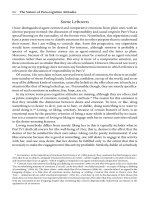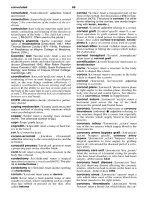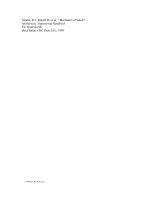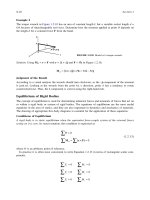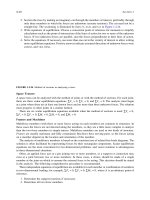CRC Press - Mechanical Engineering Handbook- Mechanics Of Solids Part 3 ppsx
Bạn đang xem bản rút gọn của tài liệu. Xem và tải ngay bản đầy đủ của tài liệu tại đây (31.76 KB, 1 trang )
1-20 Section 1
2.Section the truss by making an imaginary cut through the members of interest, preferably through
only three members in which the forces are unknowns (assume tensions). The cut need not be a
straight line. The sectioning is illustrated by lines l-l, m-m, and n-n in Figure 1.2.24.
3.Write equations of equilibrium. Choose a convenient point of reference for moments to simplify
calculations such as the point of intersection of the lines of action for two or more of the unknown
forces. If two unknown forces are parallel, sum the forces perpendicular to their lines of action.
4.Solve the equations. If necessary, use more than one cut in the vicinity of interest to allow writing
more equilibrium equations. Positive answers indicate assumed directions of unknown forces were
correct, and vice versa.
Space Trusses
A space truss can be analyzed with the method of joints or with the method of sections. For each joint,
there are three scalar equilibrium equations, ∑F
x
= 0, ∑F
y
= 0, and ∑F
z
= 0. The analysis must begin
at a joint where there are at least one known force and no more than three unknown forces. The solution
must progress to other joints in a similar fashion.
There are six scalar equilibrium equations available when the method of sections is used: ∑F
x
= 0,
∑F
y
= 0, ∑F
z
= 0, ∑M
x
= 0, ∑M
y
= 0, and ∑M
z
= 0.
Frames and Machines
Multiforce members (with three or more forces acting on each member) are common in structures. In
these cases the forces are not directed along the members, so they are a little more complex to analyze
than the two-force members in simple trusses. Multiforce members are used in two kinds of structure.
Frames are usually stationary and fully constrained. Machines have moving parts, so the forces acting
on a member depend on the location and orientation of the member.
The analysis of multiforce members is based on the consistent use of related free-body diagrams. The
solution is often facilitated by representing forces by their rectangular components. Scalar equilibrium
equations are the most convenient for two-dimensional problems, and vector notation is advantageous
in three-dimensional situations.
Often, an applied force acts at a pin joining two or more members, or a support or connection may
exist at a joint between two or more members. In these cases, a choice should be made of a single
member at the joint on which to assume the external force to be acting. This decision should be stated
in the analysis. The following comprehensive procedure is recommended.
Three independent equations of equilibrium are available for each member or combination of members
in two-dimensional loading; for example, ∑F
x
= 0, ∑F
y
= 0, ∑M
A
= 0, where A is an arbitrary point of
reference.
1.Determine the support reactions if necessary.
2.Determine all two-force members.
FIGURE 1.2.24Method of sections in analyzing a truss.




